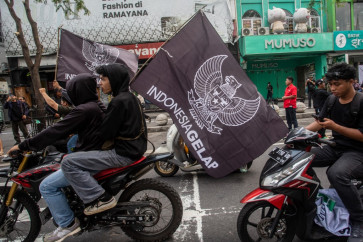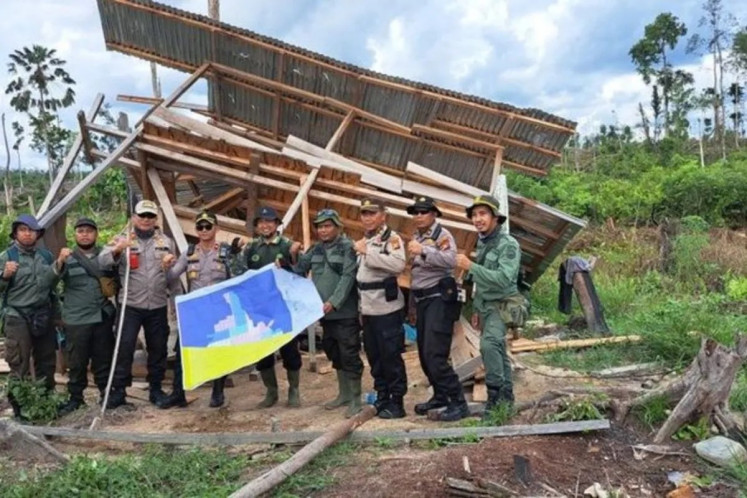Popular Reads
Top Results
Can't find what you're looking for?
View all search resultsPopular Reads
Top Results
Can't find what you're looking for?
View all search resultsWorst-case scenario being prepared for Mt. Sinabung
Playtime: Children play in front of tents at the Batak Karo Protestan Klasis Church (GBKP) building in Brastagi, North Sumatra, on Sunday
Change text size
Gift Premium Articles
to Anyone
P
span class="caption">Playtime: Children play in front of tents at the Batak Karo Protestan Klasis Church (GBKP) building in Brastagi, North Sumatra, on Sunday. These children's families took shelter at the church after Mount Sinabung's eruption. As the volcano's daily eruptions have intensified, more and more people have left their homes and taken shelter at safer places. The total number of people who have taken refuge in various places has reached 20,491. Antara/Irsan Mulyadi
The National Disaster Mitigation Agency (BNPB) has instructed all relevant ministries, government institutions, local disaster mitigation agencies and the Karo regency administration in North Sumatra to prepare for a worst-case scenario following an increase in Mount Sinabung's volcanic activity during the past week.
The worst-case scenario would be applied if the evacuation zone reaches between 7.5 kilometers and 10 km from the crater.
Currently, the evacuation zone is still between 5 and 7 km on the southeast slope of the volcano.
'No activity is allowed on this side of the volcano. It has to be free of any activity,' BNPB spokesperson Sutopo Purwo Nugroho told The Jakarta Post on Saturday.
He said this particular part of the volcano was particularly vulnerable to disaster as it was the lane for the volcano's pyroclastic flows.
He added that there were already 60 pyroclastic flows running from the crater of Mt. Sinabung, stretching to a distance of between 2 and 5 km down the slope of the volcano. He also said that the volume of the pyroclastic flows was increasing every day.
In light of the potential danger proposed by the flows, Sutopo said, the emergency response team had evacuated people from the two subdistricts of Jerawa and Pintu Besi, which are located along the tracks of the flows. The two subdistricts are located 6.5 km from the crater.
With this latest evacuation, the number of displaced persons has currently reached more than 6,300 families, comprising over 20,000 people. They are being accommodated at 32 evacuation centers.
Sutopo said that BNPB head Syamsul Maarif had instructed all relevant institutions to prepare mitigation measures.
'Learning from Mount Merapi's eruptions in 2010, during which increased volcanic activity was followed by an increase in the evacuation radius from 5 km to 10, 15 and then 20 km, preparations for dealing with evacuees must be conducted well,' he said, referring to one of the world's most active volcanoes that is located on the border of Central Java and Yogyakarta.
Mt. Sinabung reportedly erupted again on Saturday. As of 4 p.m. that day, the volcano was recorded to have erupted 37 times with volcanic ash reaching up to 4 km high and heading in a southerly direction.
The volcano's observation team reported that the pyroclastic flows on Saturday stretched up to 4.5 km down Sinabung's southeast slope. This is considered the longest flows so far, as up until three days prior to Saturday, they only stretched 3 km down the slope.
Sutopo said that as of 6 a.m. on Sunday, the volcano had erupted 77 times since Saturday with volcanic material being expelled some 500 meters to 4,500 meters into the air.
A member of the observation team, Ahmad Nabawi, said that so far the volcanic material comprised one quarter of the total 2,540,000 cubic meters formed in Mt. Sinabung's crater. 'This means that the pyroclastic potential stored in the volcano's lava dome is still substantial; so if it should all come out, the threat would be devastating,' Nabawi said in Simpang Empat district, Karo, on Saturday.
Commander of the Mt. Sinabung emergency response team, Lt. Col Meyer Putong, said that in line with the increase in Sinabung's volcanic activity, the emergency response period had been extended from Sunday to Jan. 18.
He said a further extension was possible if Sinabung's volcanic activity continued to increase.
'We call on people to remain alert and follow the government's instructions,' said Meyer, who is also commander of the 0205/Tanah Karo Military District Command (Kodim).
Meanwhile, the Volcanology and Geological Disaster Mitigation Center (PVMBG) has increased the status of Mount Raung from normal to waspada or 'alert', the third level in the four-tier warning system.
Sutopo said the change in the warning level had been implemented due to increasing tremors and the change in the color of smoke, becoming brownish white, since Saturday.
'Currently, the threat is limited to around the crater,' he said as quoted by Antara news agency.
'Therefore, we are advising local residents and climbers not to approach the summit beyond a radius of 2 km from the center of the crater.'










